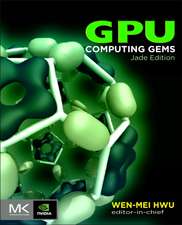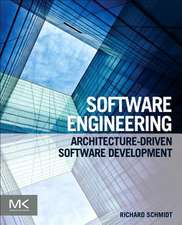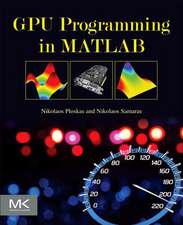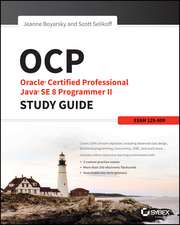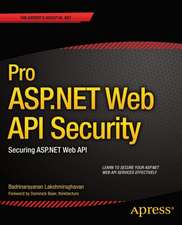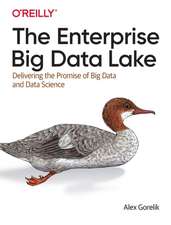System Assurance: Beyond Detecting Vulnerabilities: The MK/OMG Press
Autor Nikolai Mansourov, Djenana Camparaen Limba Engleză Paperback – 28 dec 2010
OMG’s Assurance Ecosystem provides a common framework for discovering, integrating, analyzing, and distributing facts about existing enterprise software. Its foundation is the standard protocol for exchanging system facts, defined as the OMG Knowledge Discovery Metamodel (KDM). In addition, the Semantics of Business Vocabularies and Business Rules (SBVR) defines a standard protocol for exchanging security policy rules and assurance patterns. Using these standards together, students will learn how to leverage the knowledge of the cybersecurity community and bring automation to protect systems.
This book includes an overview of OMG Software Assurance Ecosystem protocols that integrate risk, architecture, and code analysis guided by the assurance argument. A case study illustrates the steps of the System Assurance Methodology using automated tools.
This book is recommended for technologists from a broad range of software companies and related industries; security analysts, computer systems analysts, computer software engineers-systems software, computer software engineers- applications, computer and information systems managers, network systems and data communication analysts.
- Provides end-to-end methodology for systematic, repeatable, and affordable System Assurance.
- Includes an overview of OMG Software Assurance Ecosystem protocols that integrate risk, architecture and code analysis guided by the assurance argument.
- Case Study illustrating the steps of the System Assurance Methodology using automated tools.
Preț: 302.78 lei
Preț vechi: 378.47 lei
-20% Nou
Puncte Express: 454
Preț estimativ în valută:
57.96€ • 62.97$ • 48.71£
57.96€ • 62.97$ • 48.71£
Carte tipărită la comandă
Livrare economică 15-29 aprilie
Preluare comenzi: 021 569.72.76
Specificații
ISBN-13: 9780123814142
ISBN-10: 0123814146
Pagini: 368
Ilustrații: Illustrated
Dimensiuni: 191 x 235 x 20 mm
Greutate: 0.6 kg
Editura: ELSEVIER SCIENCE
Seria The MK/OMG Press
ISBN-10: 0123814146
Pagini: 368
Ilustrații: Illustrated
Dimensiuni: 191 x 235 x 20 mm
Greutate: 0.6 kg
Editura: ELSEVIER SCIENCE
Seria The MK/OMG Press
Public țintă
Technologists from a broad range of software companies and related industries; Computer Systems Analysts, Computer Software Engineers-Systems Software, Computer Software Engineers- Applications, Computer and Information Systems Managers, Network systems and Data Communication Analysts.Cuprins
Contents
1. Why Hackers know more about our systems
1.1 Operating in cyberspace involves risks
1.2 Why Hackers are repeatadly successful
1.2.1 What are the challenges in defending cybersystems?
1.2.1.1 Difficulties in understanding and assessing risks
1.2.1.2 Understanding Development Trends
1.2.1.3 Comprehending Systems’ Complexity
1.2.1.4 Understanding Assessment Practices and their Limitations
1.2.1.5 Vulnerability Scanning Technologies and their Issues
1.3 Where do We Go from Here
1.3.1 Systematic and repeatable defense at affordable cost
1.3.2 The OMG Software Assurance Ecosystem
1.3.3 Linguistic Modeling to manage the common vocabulary
1.4 Who should read this book
2 Chapter: Confidence as a Product
2.1 Are you confident that there is no black cat in the dark room?
2.2 The Nature of Assurance
2.2.1 Engineering, Risk and Assurance
2.2.2 Assurance Case (AC)
2.2.2.1 Contents of an Assurance Case
2.2.2.2 Structure of the Assurance Argument
2.3 Overview of the Assurance Process
2.3.1 Producing Confidence
2.3.1.1 Economics of Confidence
3 Chapter: How to Build Confidence
3.1 Assurance in the System Lifecycle
3.2 Activities of System Assurance Process
3.2.1 Project Definition
3.2.2 Project Preparation
3.2.3 Assurance argument development
3.2.4 Architecture Security Analysis
3.2.4.1 Discover System Facts
3.2.4.2 Threat identification
3.2.4.3 Safeguard Identification
3.2.4.4 Vulnerability detection
3.2.4.5 Security Posture Analysis
3.2.5 Evidence analysis
3.2.6 Assurance Case Delivery
4 Chapter: Knowledge of System as of Element in Cybersecurity argument
4.1 What is system
4.2 Boundaries of the system
4.3 Resolution of the system description
4.4 Conceptual commitment for system descriptions
4.5 System architecture
4.6 Example of an architecture framework
4.7 Elements of System
4.8 System Knowledge Involves Multiple Viewpoints
4.9 Concept of operations (CONOP)
4.10 Network Configuration
4.11 System life cycle and assurance
4.11.1 System life cycle stages
4.11.2 Enabling Systems
4.11.3 Supply Chain
4.11.4 System life cycle processes
4.11.5 The implications to the common vocabulary and the integrated system model
5 Chapter: Knowledge of Risk as an Element of Cybersecurity argument
5.1 Introduction
5.2 Basic cybersecurity elements
5.3 Common vocabulary for risk analysis
5.3.1 Defining diScernable vocabulary for Assets
5.3.2 Threats and hazards
5.3.3 Defining dicernable vocabulary for Injury and Impact
5.3.4 Defining dicernable vocabulary for threats
5.3.5 Threat scenarios and attacks
5.3.6 Defining dicernable vocabulary for vulnerabilities
5.3.7 Defining dicernable vocabulary for safeguards
5.3.8 Risk
5.4 Systematic Threat Identification
5.5 Assurance Strategies
5.5.1 Injury Argument
5.5.2 Entry point argument
5.5.3 Threat argument
5.5.4 Vulnerability argument
5.5.5 Security requirement argument
5.5.6 Assurance of the threat identification
6 Chapter: Knowledge of Vulnerabilities as an Element of Cybersecurity Argument
6.1 Vulnerability as part of system knowledege
6.1.1 What is Vulnerability
6.1.2 Vulnerability as Unit of Knowledge: The History of Vulnerability
6.1.3 Vulnerabilities and the Phases of the System Life Cycle
6.1.4 Enumeration of Vulnerabilities as a Knowledge Product
6.1.5 Vulnerability Databases
6.1.5.1 US-CERT
6.1.5.2 Open Source Vulnerability Database (OSVDB)
6.1.6 Vulnerability Life Cycle
6.2 NIST Security Content Automation Protocol (SCAP) Ecosystem
6.2.1 Overview of SCAP Ecosystem
6.2.2 Information Exchanges under SCAP
7 Chapter: Vulnerability Patterns as a New Assurance Content
7.1 Beyond Current SCAP Ecosystem
7.2 Vulnerability Patterns
7.3 Software Fault Patterns
7.3.1 Safeguard category of clusters and corresponding Software fault Patterns (SFPs)
7.3.1.1 Authentication
7.3.1.2 Access Control
7.3.1.3 Privilege
7.3.2 Direct Impact category of clusters and corresponding Software fault Patterns (SFPs)
7.3.2.1 Information Leak
7.3.2.2 Memory Management
7.3.2.3 Memory Access
7.3.2.4 Path Resolution
7.3.2.5 Tainted Input
8 Chapter: OMG Software Assurance Ecosystem
8.1 Introduction
8.2 OMG Assurance Ecosystem: towards collaborative cybersecurity
9 Chapter: Common Fact Model for Assurance Content
9.1 Assurance Content
9.2 The Objectives
9.3 Design criteria for information exchange protocols
9.4 Tradeoffs
9.5 Information Exchange Protocols
9.6 The Nuts and Bolts of Fact Models
9.6.1 Objects
9.6.2 Noun Concepts
9.6.3 Facts about existence of objects
9.6.4 Individual concepts
9.6.5 Relations between concepts
9.6.6 Verb concepts
9.6.7 Characteristics
9.6.8 Situational concepts
9.6.9 Viewpoints and views
9.6.10 Information exchanges and assurance
9.6.11 Fact-oriented Integration
9.6.12 Automatic derivation of facts
9.7 The representation of facts
9.7.1 Representing facts in XML
9.7.2 Representing facts and schemes in Prolog
9.8 The common schema
9.9 System assurance facts
10 Chapter: Linguistic Models
10.1 Fact Models and Linguistic Models
10.2 Background
10.3 Overview of SBVR
10.4 How to use SBVR
10.4.1 Simple vocabulary
10.4.2 Vocabulary Entries
10.4.3 Statements
10.4.4 Statements as formal definitions of new concepts
10.4.4.1 Definition of a Noun Concept
10.4.4.2 Definition of a Verb Concept
10.4.4.3 The General Concept caption
10.5 SBVR Vocabulary for describing Elementary Meanings
10.6 SBVR Vocabulary for describing Representations
10.7 SBVR Vocabulary for describing Extensions
10.8 Reference schemes
10.9 SBVR Semantic Formulations
10.9.1 Defining new terms and facts types using SBVR
11 Chapter: Standard Protocol for Exchanging System Facts
11.1 Background
11.2 Organization of the KDM vocabulary
11.2.1 Infrastructure Layer
11.2.2 Program Elements Layer
11.2.3 Resource Layer
11.2.4 Abstractions Layer
11.3 The process of discovering system facts
11.4 Discovering the baseline system facts
11.4.1 Inventory views
11.4.1.1 Inventory Viewpoint vocabulary in SBVR
11.4.2 Build Views
11.4.3 Data views
11.4.4 UI views
11.4.5 Code views
11.4.5.1 Code views: Elements of Structure
11.4.5.2 Code views: Elements of Behavior
11.4.5.3 Micro KDM
11.4.6 Platform views
11.4.7 Event views
11.5 Performing architecture analysis
11.5.1 Structure Views
11.5.2 Conceptual Views
11.5.2.1 Linguistic Viewpoint
11.5.2.2 Behavior Viewpoint
12 Chapter: Case Study
12.1 Introduction
12.2 Background
12.3 Concepts of operations
12.3.1 Executive summary
12.3.2 Purpose
12.3.3 Locations
12.3.4 Operational Authority
12.3.5 System Architecture
12.3.5.1 Clicks2Bricks Web server
12.3.5.2 Database server
12.3.5.3 SMTP server
12.3.6 System Assumptions
12.3.7 External dependencies
12.3.8 Implementation Assumptions
12.3.9 Interfaces with Other Systems
12.3.10 Security assumptions
12.3.11 External Security Notes
12.3.12 Internal Security notes
12.4 Business vocabulary and security policy for Clicks2Bricks in SBVR
12.5 Building the integrated system model
12.5.1 Building the baseline system model
12.5.2 Enhancing the baseline model with the system architecture facts
12.6 Mapping cybersecurity facts to system facts
12.7 Assurance case
1. Why Hackers know more about our systems
1.1 Operating in cyberspace involves risks
1.2 Why Hackers are repeatadly successful
1.2.1 What are the challenges in defending cybersystems?
1.2.1.1 Difficulties in understanding and assessing risks
1.2.1.2 Understanding Development Trends
1.2.1.3 Comprehending Systems’ Complexity
1.2.1.4 Understanding Assessment Practices and their Limitations
1.2.1.5 Vulnerability Scanning Technologies and their Issues
1.3 Where do We Go from Here
1.3.1 Systematic and repeatable defense at affordable cost
1.3.2 The OMG Software Assurance Ecosystem
1.3.3 Linguistic Modeling to manage the common vocabulary
1.4 Who should read this book
2 Chapter: Confidence as a Product
2.1 Are you confident that there is no black cat in the dark room?
2.2 The Nature of Assurance
2.2.1 Engineering, Risk and Assurance
2.2.2 Assurance Case (AC)
2.2.2.1 Contents of an Assurance Case
2.2.2.2 Structure of the Assurance Argument
2.3 Overview of the Assurance Process
2.3.1 Producing Confidence
2.3.1.1 Economics of Confidence
3 Chapter: How to Build Confidence
3.1 Assurance in the System Lifecycle
3.2 Activities of System Assurance Process
3.2.1 Project Definition
3.2.2 Project Preparation
3.2.3 Assurance argument development
3.2.4 Architecture Security Analysis
3.2.4.1 Discover System Facts
3.2.4.2 Threat identification
3.2.4.3 Safeguard Identification
3.2.4.4 Vulnerability detection
3.2.4.5 Security Posture Analysis
3.2.5 Evidence analysis
3.2.6 Assurance Case Delivery
4 Chapter: Knowledge of System as of Element in Cybersecurity argument
4.1 What is system
4.2 Boundaries of the system
4.3 Resolution of the system description
4.4 Conceptual commitment for system descriptions
4.5 System architecture
4.6 Example of an architecture framework
4.7 Elements of System
4.8 System Knowledge Involves Multiple Viewpoints
4.9 Concept of operations (CONOP)
4.10 Network Configuration
4.11 System life cycle and assurance
4.11.1 System life cycle stages
4.11.2 Enabling Systems
4.11.3 Supply Chain
4.11.4 System life cycle processes
4.11.5 The implications to the common vocabulary and the integrated system model
5 Chapter: Knowledge of Risk as an Element of Cybersecurity argument
5.1 Introduction
5.2 Basic cybersecurity elements
5.3 Common vocabulary for risk analysis
5.3.1 Defining diScernable vocabulary for Assets
5.3.2 Threats and hazards
5.3.3 Defining dicernable vocabulary for Injury and Impact
5.3.4 Defining dicernable vocabulary for threats
5.3.5 Threat scenarios and attacks
5.3.6 Defining dicernable vocabulary for vulnerabilities
5.3.7 Defining dicernable vocabulary for safeguards
5.3.8 Risk
5.4 Systematic Threat Identification
5.5 Assurance Strategies
5.5.1 Injury Argument
5.5.2 Entry point argument
5.5.3 Threat argument
5.5.4 Vulnerability argument
5.5.5 Security requirement argument
5.5.6 Assurance of the threat identification
6 Chapter: Knowledge of Vulnerabilities as an Element of Cybersecurity Argument
6.1 Vulnerability as part of system knowledege
6.1.1 What is Vulnerability
6.1.2 Vulnerability as Unit of Knowledge: The History of Vulnerability
6.1.3 Vulnerabilities and the Phases of the System Life Cycle
6.1.4 Enumeration of Vulnerabilities as a Knowledge Product
6.1.5 Vulnerability Databases
6.1.5.1 US-CERT
6.1.5.2 Open Source Vulnerability Database (OSVDB)
6.1.6 Vulnerability Life Cycle
6.2 NIST Security Content Automation Protocol (SCAP) Ecosystem
6.2.1 Overview of SCAP Ecosystem
6.2.2 Information Exchanges under SCAP
7 Chapter: Vulnerability Patterns as a New Assurance Content
7.1 Beyond Current SCAP Ecosystem
7.2 Vulnerability Patterns
7.3 Software Fault Patterns
7.3.1 Safeguard category of clusters and corresponding Software fault Patterns (SFPs)
7.3.1.1 Authentication
7.3.1.2 Access Control
7.3.1.3 Privilege
7.3.2 Direct Impact category of clusters and corresponding Software fault Patterns (SFPs)
7.3.2.1 Information Leak
7.3.2.2 Memory Management
7.3.2.3 Memory Access
7.3.2.4 Path Resolution
7.3.2.5 Tainted Input
8 Chapter: OMG Software Assurance Ecosystem
8.1 Introduction
8.2 OMG Assurance Ecosystem: towards collaborative cybersecurity
9 Chapter: Common Fact Model for Assurance Content
9.1 Assurance Content
9.2 The Objectives
9.3 Design criteria for information exchange protocols
9.4 Tradeoffs
9.5 Information Exchange Protocols
9.6 The Nuts and Bolts of Fact Models
9.6.1 Objects
9.6.2 Noun Concepts
9.6.3 Facts about existence of objects
9.6.4 Individual concepts
9.6.5 Relations between concepts
9.6.6 Verb concepts
9.6.7 Characteristics
9.6.8 Situational concepts
9.6.9 Viewpoints and views
9.6.10 Information exchanges and assurance
9.6.11 Fact-oriented Integration
9.6.12 Automatic derivation of facts
9.7 The representation of facts
9.7.1 Representing facts in XML
9.7.2 Representing facts and schemes in Prolog
9.8 The common schema
9.9 System assurance facts
10 Chapter: Linguistic Models
10.1 Fact Models and Linguistic Models
10.2 Background
10.3 Overview of SBVR
10.4 How to use SBVR
10.4.1 Simple vocabulary
10.4.2 Vocabulary Entries
10.4.3 Statements
10.4.4 Statements as formal definitions of new concepts
10.4.4.1 Definition of a Noun Concept
10.4.4.2 Definition of a Verb Concept
10.4.4.3 The General Concept caption
10.5 SBVR Vocabulary for describing Elementary Meanings
10.6 SBVR Vocabulary for describing Representations
10.7 SBVR Vocabulary for describing Extensions
10.8 Reference schemes
10.9 SBVR Semantic Formulations
10.9.1 Defining new terms and facts types using SBVR
11 Chapter: Standard Protocol for Exchanging System Facts
11.1 Background
11.2 Organization of the KDM vocabulary
11.2.1 Infrastructure Layer
11.2.2 Program Elements Layer
11.2.3 Resource Layer
11.2.4 Abstractions Layer
11.3 The process of discovering system facts
11.4 Discovering the baseline system facts
11.4.1 Inventory views
11.4.1.1 Inventory Viewpoint vocabulary in SBVR
11.4.2 Build Views
11.4.3 Data views
11.4.4 UI views
11.4.5 Code views
11.4.5.1 Code views: Elements of Structure
11.4.5.2 Code views: Elements of Behavior
11.4.5.3 Micro KDM
11.4.6 Platform views
11.4.7 Event views
11.5 Performing architecture analysis
11.5.1 Structure Views
11.5.2 Conceptual Views
11.5.2.1 Linguistic Viewpoint
11.5.2.2 Behavior Viewpoint
12 Chapter: Case Study
12.1 Introduction
12.2 Background
12.3 Concepts of operations
12.3.1 Executive summary
12.3.2 Purpose
12.3.3 Locations
12.3.4 Operational Authority
12.3.5 System Architecture
12.3.5.1 Clicks2Bricks Web server
12.3.5.2 Database server
12.3.5.3 SMTP server
12.3.6 System Assumptions
12.3.7 External dependencies
12.3.8 Implementation Assumptions
12.3.9 Interfaces with Other Systems
12.3.10 Security assumptions
12.3.11 External Security Notes
12.3.12 Internal Security notes
12.4 Business vocabulary and security policy for Clicks2Bricks in SBVR
12.5 Building the integrated system model
12.5.1 Building the baseline system model
12.5.2 Enhancing the baseline model with the system architecture facts
12.6 Mapping cybersecurity facts to system facts
12.7 Assurance case
Recenzii
"The Object Management Group (OMG) Software Assurance Ecosystem described in this book is a significant step towards collaborative cyber security automation; it offers a standards-based solution for building security and resilience in computer systems." --Joe Jarzombek, Director for Software Assurance, Global Cyber Security Management, National Cyber Security Division, Department of Homeland Security
"System Assurance is a very complex and difficult subject. This book successfully demonstrates and describes in detail how to combine different existing tools together in order to systematically develop System Assurance documentation and justification in a practical manner for a specific domain. The book provides very useful practical guidance that can be used by technical and management practitioners for the specific domain described, and by example for others for different domains." --John P. Hopkinson, Security Strategist, Kwictech
"System Assurance is a very complex and difficult subject. This book successfully demonstrates and describes in detail how to combine different existing tools together in order to systematically develop System Assurance documentation and justification in a practical manner for a specific domain. The book provides very useful practical guidance that can be used by technical and management practitioners for the specific domain described, and by example for others for different domains." --John P. Hopkinson, Security Strategist, Kwictech













